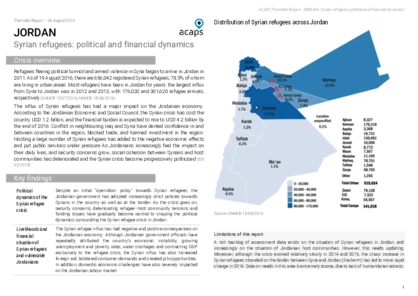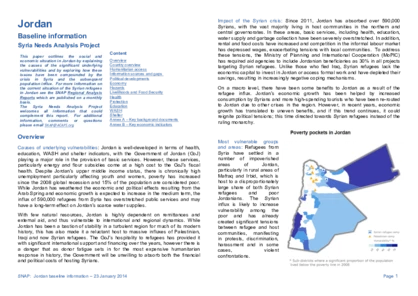Latest updates on country situation
29 March 2023
12 years since the onset of the Syrian refugee crisis in 2011, living conditions for the nearly 1.3 million Syrian refugees in Jordan remain precarious. More than half of these refugees live in poverty, and one fifth are food-insecure.
In the last quarter of 2022, more than 80% of refugee households were in debt, with most of them borrowing money from friends and neighbours to cover basic needs, such as food and rent. Also in 2022, around 90% of refugee households used at least one negative coping mechanism, such as reducing non-food expenses and withdrawing children from school.
As at January 2023, around 80% of refugees lived outside camps in poor housing, and shelters in camps remained inadequate and unsafe. In the last three months of 2022, around 34% of refugee households had difficulty in paying rent, and 26% received eviction notices. Livelihood, food security, shelter, and protection assistance are some of the key priorities for Syrian refugees in Jordan.
(UNHCR 26/02/2023, UNHCR/WB 13/03/2023, UNHCR 26/02/2023, OCHA 30/06/2022, UNHCR accessed 29/03/2023, 3RP 09/01/2023)
current crises
in
Jordan
These crises have been identified through the INFORM Severity Index, a tool for measuring and comparing the severity of humanitarian crises globally.
JOR002 - Displacement from Syria
Last updated 27/11/2025
Drivers
International Displacement
Crisis level
Country
Severity level
3 Medium
Access constraints
2.0
Analysis products
on
Jordan
24 August 2016
Jordan: Syrian refugees - political and financial dynamics
DOCUMENT / PDF / 481 KB
Refugees fleeing political turmoil and armed violence in Syria began to arrive in Jordan in 2011. As of 19 August 2016, there are 656,042 registered Syrian refugees, 78.5% of whom are living in urban areas. Most refugees have been in Jordan for years: the largest influx from Syria to Jordan was in 2012 and 2013, with 176,020 and 301,620 refugee arrivals, respectively.
23 January 2014
Syria Needs Analysis Project: Jordan
DOCUMENT / PDF / 2 MB
This paper outlines the social and economic situation in Jordan by explaining the causes of the significant underlying vulnerabilities and by exploring how these issues have been compounded by the crisis in Syria and the subsequent population influx.



